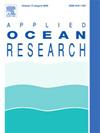Reconstruction analysis of blades models of floating offshore wind turbine utilizing genetic algorithm and feedforward neural network
Abstract
The contradiction between Reynolds similarity and Froude similarity often leads to underperformance in thrust during wind-wave basin physical model tests of floating offshore wind turbine (FOWT), compromising the accuracy of experimental results. This study proposes a novel blade model reconstruction method that combines the third-generation non-dominated sorting genetic algorithm (NSGA-III) and feedforward neural network (FNN), aiming to ensure that the thrust of the model wind turbine matches that of the full-scale model, adhering to Froude similarity principles. The chord and twist angles of the FOWT blades are optimized using NSGA-III, resulting in blade parameters that satisfy thrust similarity. The data derived from the NSGA-III optimization process are utilized for training the FNN, which predicts blade design parameters rapidly based on desired thrust. The data predicted by the FNN are used to remodel the FOWT rotor, and the results are compared with those obtained from NSGA-III. The results demonstrate that the FOWT thrust based on the blade design parameters predicted by the FNN aligns well with the desired thrust of the FOWT model, proving the feasibility of using the FNN for rapid blade reconstruction.

 求助内容:
求助内容: 应助结果提醒方式:
应助结果提醒方式:


